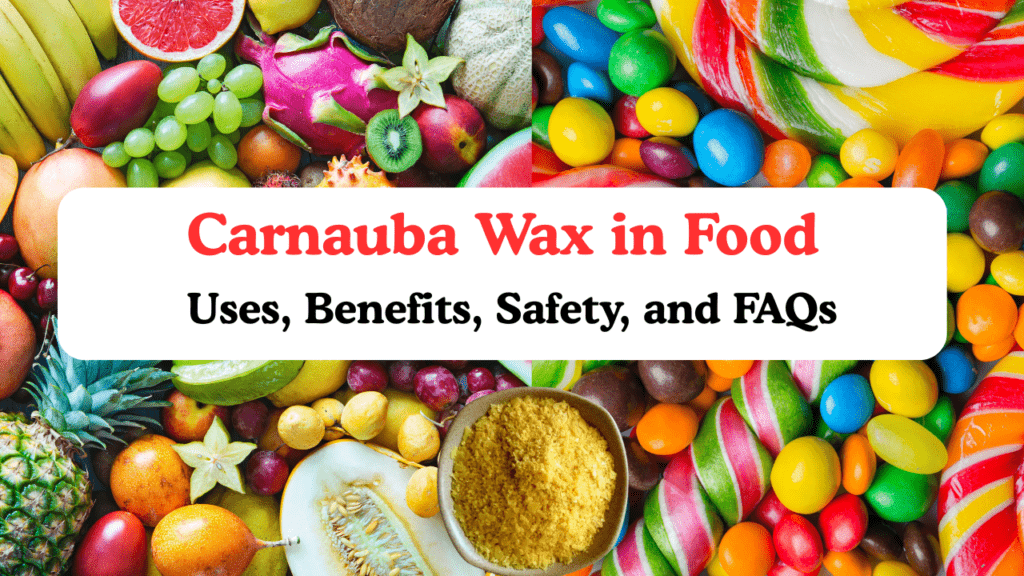
Introduction
Carnauba wax, also called the “Queen of Waxes,” is a natural wax that comes from plants. It is strong, has a high melting point, and gives a shiny finish. Because of these qualities, it is used in many foods like candy, fruits, and cheese.
But what is carnauba wax exactly, how is it used, and is it safe? This guide explains its origin, what it’s made of, how it’s used in food, its safety, environmental effects, and answers to common questions.
What Is Carnauba Wax ?
Carnauba wax is a hard, brittle wax harvested from the leaves of the Copernicia prunifera palm tree, also known as the carnauba palm. The wax naturally forms a protective coating on the leaves during hot and dry weather, serving as a shield against environmental elements.
During harvesting, the mature leaves are dried, and the wax flakes are carefully beaten off before being refined through melting and filtering to remove impurities. This sustainable harvesting process does not harm the trees when done responsibly, and strict regulations limit leaf removal to maintain tree health.
Chemical Composition & Physical Properties
Carnauba wax is a complex, amorphous blend of:
- Fatty acid esters: 80–85%
- Fatty alcohols: 10–16%
- Free fatty acids: 3–6%
- Hydrocarbons and trace elements: 1–3%
Notably, it contains high proportions of diesters (particularly 4-hydroxycinnamic acid diesters, about 21% by weight), ω-hydroxycarboxylic acids (13%), and fatty alcohols (12%) .
Its melting point ranges between 82–85 °C (around 180–185 °F)—making it one of the toughest natural waxes. It’s insoluble in water and ethanol, though soluble in certain organic solvents when heated.
This unique chemical and physical profile contributes to its durability, glossiness, and stability—ideal for food applications.
Why Is Carnauba Wax Used in Food ?
Protective Coating
One of the primary uses of carnauba wax in the food industry is as a protective coating for fruits, vegetables, candies, and other edible products.
When applied as a thin layer, carnauba wax forms a moisture-resistant barrier that helps preserve freshness by reducing water loss and defending against mold growth.
This extends the shelf life of perishable items like apples, cucumbers, and citrus fruits, which can otherwise spoil quickly.
Enhances Appearance and Texture
Carnauba wax provides a glossy, shiny finish that enhances the visual appeal of food products. This is particularly valuable in confectionery, as seen in candies, chocolates, and chewing gum, where the wax prevents melting and sticking, while giving products a polished surface and slight crunch.
It’s also used in hard cheeses like Gouda and Cheddar where it acts as a protective shell that preserves flavor and texture.
Food-Grade and Non-Toxic
The food-grade version of carnauba wax is approved for direct contact with food by numerous regulatory authorities worldwide. Being natural, it is tasteless, odorless, and non-toxic, making it an excellent choice for food preservation and finishing applications without harmful effects.
Environmental and Ethical Considerations
The carnauba palm grows naturally in specific Brazilian regions, making it a geographically restricted resource. To prevent deforestation and ecological damage, strict harvesting regulations are in place, allowing only 10-20 leaves to be collected per tree at a time.
Trees that are over-harvested can experience stunted growth or even die, affecting the surrounding ecosystems dependent on them.
Companies are encouraged to ensure responsible sourcing and fair wages for harvesters, supporting both environmental sustainability and local communities. Ethical harvesting is crucial to preserving carnauba wax availability and protecting the natural habitat.
Is Carnauba Wax Safe in Food ?
Carnauba wax used in food is considered safe and non-toxic by regulatory authorities such as the FDA and EFSA. It is a natural plant wax that undergoes careful refining to remove impurities before being approved for direct food contact. Its safety profile is supported by research showing the wax is mostly inert when ingested; it passes through the digestive system without being absorbed or causing harm.
In addition, carnauba wax is tasteless, odorless, and does not interact chemically with the food it coats. As a result, it is commonly found on fruits, candies, chewing gums, and hard cheeses, where it prolongs freshness without posing health risks.
While carnauba wax is generally safe, people with rare allergies to it should avoid products containing this ingredient. Overall, for the vast majority of consumers, carnauba wax is a reliable and safe food additive.
Is Carnauba Wax Good for the Human Body ?
Carnauba wax itself does not provide direct nutritional benefits since it is not metabolized or absorbed by the body. However, it contains natural components such as fatty acids, natural alcohols, and hydrocarbons, which are largely inert during digestion.
Interestingly, its hypoallergenic and emollient properties have led to its use in topical products like cosmetics and pharmaceuticals, supporting skin protection and moisture retention without irritation.
Though health benefits from ingestion are minimal, carnauba wax helps maintain the quality and safety of the food it coats, indirectly supporting health by reducing food spoilage and contamination risks.
Carnauba Wax in Food Benefits
Extended Shelf Life
Carnauba wax helps food last longer. It creates a thin, water-proof layer on fruits and vegetables that keeps them from drying out and stops mold from growing. This helps keep the food fresh and reduces waste.
Enhanced Appearance
Carnauba wax gives foods a shiny and smooth surface. This makes candies, chocolates, and fresh fruits look more appealing and nice to customers.
Improved Texture and Protection
In sweets, carnauba wax stops them from melting or sticking together by forming a protective cover. For hard cheeses, the wax keeps the texture and flavor fresh by stopping air and moisture from damaging them.
Natural and Food-Safe
Derived from a plant source, carnauba wax is biodegradable and safe for food use, making it a preferred alternative to synthetic wax coatings.
What’s the best food safe oil for cutting boards?
What Are the Side Effects of Carnauba Wax?
Carnauba wax is generally regarded as safe, and side effects are extremely rare. However, some considerations include:
Allergic Reactions:
Although uncommon, some individuals may experience allergic skin reactions or sensitivities. If irritation occurs, avoidance of carnauba wax-containing products is advised.
Cosmetic-Related Eye Irritation:
In eye makeup products containing carnauba wax, clogged oil glands may cause dry eye symptoms for sensitive users. This emphasizes the importance of product formulation and usage guidelines.
Processed Blends Concerns:
Carnauba wax is sometimes blended with synthetic chemicals and solvents in industrial products. These additives may pose health risks if not carefully controlled. Choosing certified food-grade, natural carnauba wax minimizes such risks.
How to Use Carnauba Wax in Food
Carnauba wax is typically applied in food-grade form as a coating or additive to protect and enhance products. Common application methods include:
Fruit and Vegetable Coatings:
Fruits like apples, citrus, and cucumbers are sprayed or dipped in a carnauba wax solution after harvest. The coating dries to form a thin, protective layer that locks in moisture and provides shine.
Confectionery Coatings:
Candies, chocolates, and chewing gums receive a polished finish by being tumbled or sprayed with carnauba wax. This coating prevents sticking, melting, and surface damage.
Cheese Coatings:
Hard cheeses are sometimes coated with melted carnauba wax, applied by dipping or brushing. The wax hardens into a protective shell, preserving flavor and moisture over extended storage.
When using carnauba wax in food production, it is crucial to ensure the wax is certified food-grade and applied under controlled sanitary conditions.
Final Say
Carnauba wax is a remarkable natural wax with a broad uses in the food industry. Its unique properties as a moisture barrier, glossy finish enhancer, and safe additive make it invaluable for extending shelf life and improving the quality of many food products.
Being a plant-based, biodegradable, and sustainable resource, carnauba wax aligns well with the move toward natural and eco-conscious food production.
Consumers can enjoy food products containing carnauba wax with confidence, knowing it has been vetted for safety and quality. Awareness of rare allergies and the importance of responsible sourcing further ensure that carnauba wax remains a trustworthy component in the global food supply.
Frequently Asked Questions (FAQs)
Q1: Is carnauba wax safe to eat?
Yes, food-grade carnauba wax is safe for consumption. It is approved by regulatory authorities and is non-toxic, tasteless, and odorless.
Q2: Can carnauba wax cause allergic reactions?
Allergic reactions are very rare but possible. Symptoms may include skin irritation or discomfort. Individuals with allergies should avoid products containing carnauba wax.
Q3: How is carnauba wax different from synthetic waxes?
Carnauba wax is natural and plant-based, harvested sustainably, biodegradable, and generally regarded as safer than synthetic waxes derived from petroleum.
Q4: What foods commonly contain carnauba wax?
It is commonly used on candies, chocolates, chewing gum, fresh fruits, hard cheeses, and some fruits and vegetables to prolong freshness and improve appearance.
Q5: Does carnauba wax affect food flavor?
No, carnauba wax is tasteless and does not alter the flavor of foods coated with it.
Q6: Is carnauba wax vegan?
Yes, carnauba wax is plant-based and vegan-friendly. However, some vegans may choose to avoid it due to environmental concerns related to harvesting.
Q7: Are there any environmental concerns related to carnauba wax production?
Overharvesting can damage the carnauba palm and surrounding ecosystems. Responsible sourcing and adherence to harvesting limits are crucial to sustainability.

